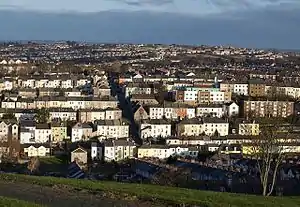Ford (Devon) railway station
Ford (Devon) railway station was originally named Ford railway station[1] and stood at the eastern end of Station Road, Keyham Barton in Plymouth, South Devon.[2][3]
Ford (Devon) | |
|---|---|
 Ford area, Plymouth | |
| Location | Plymouth, Devon England |
| Coordinates | 50.386°N 4.172°W |
| Grid reference | SX456562 |
| Platforms | 2 |
| Other information | |
| Status | Disused |
| History | |
| Original company | Plymouth, Devonport and South Western Junction Railway |
| Pre-grouping | London and South Western Railway |
| Post-grouping | Southern Railway |
| Key dates | |
| 2 June 1890[1] | Opened |
| 9 July 1923 | Renamed as Ford (Devon)[1] |
| 7 September 1964[1] | Closed |
| Railways in the Plymouth area | |||||||||||||||||||||||||||||||||||||||||||||||||||||||||||||||||||||||||||||||||||||||||||||||||||||||||||||||||||||||||||||||||||||||||||||||||||||||||||||||||||||||||||||||||||||||||||||||||||||||||||||||
|---|---|---|---|---|---|---|---|---|---|---|---|---|---|---|---|---|---|---|---|---|---|---|---|---|---|---|---|---|---|---|---|---|---|---|---|---|---|---|---|---|---|---|---|---|---|---|---|---|---|---|---|---|---|---|---|---|---|---|---|---|---|---|---|---|---|---|---|---|---|---|---|---|---|---|---|---|---|---|---|---|---|---|---|---|---|---|---|---|---|---|---|---|---|---|---|---|---|---|---|---|---|---|---|---|---|---|---|---|---|---|---|---|---|---|---|---|---|---|---|---|---|---|---|---|---|---|---|---|---|---|---|---|---|---|---|---|---|---|---|---|---|---|---|---|---|---|---|---|---|---|---|---|---|---|---|---|---|---|---|---|---|---|---|---|---|---|---|---|---|---|---|---|---|---|---|---|---|---|---|---|---|---|---|---|---|---|---|---|---|---|---|---|---|---|---|---|---|---|---|---|---|---|---|---|---|---|---|
| |||||||||||||||||||||||||||||||||||||||||||||||||||||||||||||||||||||||||||||||||||||||||||||||||||||||||||||||||||||||||||||||||||||||||||||||||||||||||||||||||||||||||||||||||||||||||||||||||||||||||||||||
| |||||||||||||||||||||||||||||||||||||||||||||||||||||||||||||||||||||||||||||||||||||||||||||||||||||||||||||||||||||||||||||||||||||||||||||||||||||||||||||||||||||||||||||||||||||||||||||||||||||||||||||||
History
Ford station was built by the Plymouth, Devonport and South Western Junction Railway Company and came into use when the line from Lydford to Plymouth was opened on Monday 2 June 1890. Ford was joined by a number of new halts in 1906 such as Weston Mill Halt and Camels Head Halt that were constructed to allow a suburban service to be operated between Plymouth Friary and St Budeaux for Saltash station in response to competition from tram lines.[4] William Brown, from Gosport, was the first station master and for 30 years served at the station, retiring in 1920.[5]
The station's name in the public timetables was changed to Ford (Devon) in July 1923 to prevent confusion with Ford station in Sussex, however the name board was never altered. In 1932 one goods train, the 8:12 am from Friary to Exmouth Junction Goods Yard, called between 8.50 and 9:05 am.[5]
Goods and passenger traffic ceased from Monday 7 September 1964 along with the line between Devonport King's Road Station and St Budeaux Victoria Road Station.[5]
Infrastructure

The station stood on a double track line, partly in a cutting with two platforms, a concrete overbridge, a substantial station building with its booking office and facilities fronted by a canopy on the Down side and a small shelter on the Up.[4] A siding, opened on Thursday 1 February 1900 to deliver bricks for the Keyham Barton housing scheme, branched off the Up line near the signal box and ran towards Ford Viaduct.[5] Ford's Signal Box was opened on 12 May 1890 in conjunction with the first goods traffic and stood on the Up side of the line.[5] By 1932 all of the track work relating to the single siding and the crossover had been lifted.
The old Ford Tunnel still runs beneath Victoria Place and has a stone lining with brick sections at both portal openings. The approach cutting was infilled to permit the construction of a blocks of flats.[6]
The site today
Nothing remains of the station that was demolished in the 1970s and the old cutting infilled in the 1980s.[4] Station Road remains as indication of Ford (Devon)'s existence.
References
Notes
- Butt (1995), p. 98.
- "Devon CXXIII.3, Revised: 1892 to 1893, Published: 1894". Retrieved 13 October 2018.
- "Plymouth (Hills), Sheet 348, Revised: 1908, Published: 1911". Retrieved 13 October 2018.
- "Southern Mainline to Okehampton". Retrieved 13 October 2018.
- "Old Devonport". Retrieved 13 October 2018.
- "Forgotten Relics". Retrieved 13 October 2018.
| Preceding station | Disused railways | Following station | ||
|---|---|---|---|---|
| Camels Head Halt | London Waterloo to Plymouth Southern Railway (PD&SWJR) |
Albert Road Halt |
Sources
- Butt, R. V. J. (1995). The Directory of Railway Stations: details every public and private passenger station, halt, platform and stopping place, past and present (1st ed.). Patrick Stephens Ltd. ISBN 1-85260-508-1.CS1 maint: ref=harv (link)